Legacy Content Warning
This section of our website is no longer maintained and may not be accurate or reflect our current ideology. Please report any content you believe to be inaccurate to [email protected].
Blog
You're Using Slack Wrong - 10 Smarter Ways to Use Slack
Transforming Slack into the central communications hub of MJWebs has taken years of trial and error. In this article, I will go through everything that has worked for us.

Mitchell Musarra
Mar 31, 2020
For a communications platform like Slack to work at your organisation, it must be understood by everyone, especially those at “the top”. There need to be policies around acceptable use and best practices that are actually written down somewhere - not just passive aggressively enforced.
Transforming Slack into the central communications hub of MJWebs has taken years of trial and error. Fortunately, I have a tendency to learn things in the hardest ways possible and consequently, this has led me to the below set of guidelines I would like to share with you in hopes that it may help break down the communication barriers in your organisation.
1. Take user profiles seriously.
Slack is basically a directory of your organisation in which all members of your team are searchable and reachable within seconds. Articulating the profile fields (and adding your own custom fields) adds a firm layer of cohesion when communicating with other team members.
Force everyone to fill in their profile properly.
There is nothing more confusing and aesthetically unpleasing than each team member choosing their own profile naming convention. Make sure everyone has their full first name and last name set. If they prefer to use a nickname on the channel screen, they can fill in the “display name” field. Everyone should also fill in their job title exactly as it appears on their employment contract.
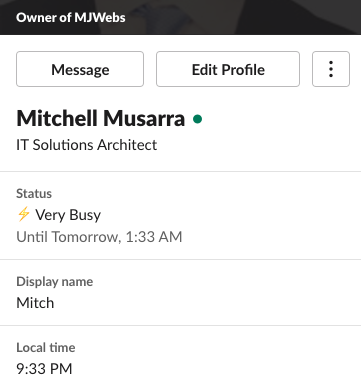
Force everyone to set a profile picture.
Holding group or individual discussions over a computer/phone screen (rocks we tricked into thinking) is already dehumanising enough. When someone neglects to find the time to upload a profile picture, it’s like talking to a faceless vessel.
Use statuses - properly.
Slack allows users to dynamically set a "status". At MJWebs, we have a policy of only choosing a status that is in the suggested list. This means everyone always knows if someone is "out of office" or just "on a break". Decide on 5 statuses for your organisation and take out the guessing game of staff reachability.
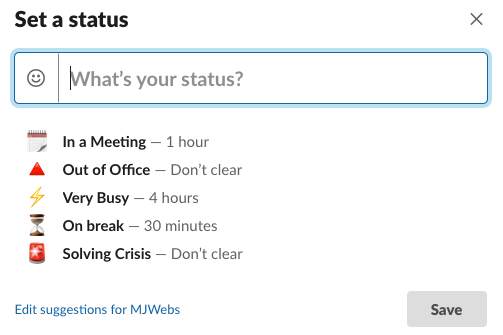
Ensure accounts are secure - use SSO or 2FA.
If your organisation is using G Suite, Office365 or Active Directory, you should definitely integrate this into Slack. If you're only using the standard username and password login, you've just provided the opportunity for a team member to reuse the same password they use for everything, opening up yet another attack vector that could compromise the security of your organisation's data.
If you are not enforcing 2FA or SSO (single sign-on), you will face compromise at some point in the future. At MJWebs, we enforce 2FA for all accounts. I highly encourage you to do the same. You can read more about this here.

2. Stop. Sending. Internal. Emails.
Sending "group emails" to your team members is a waste of everyone’s time. With the exception of communicating with external customers and vendors, MJWebs has a zero-tolerance on sending internal emails.
Use the #announcements channel for “group emails”.
When you feel yourself opening your email account and typing "Hi Everyone....", remember that you have a modern communication platform called Slack running in the background. It's easy to set the permissions of the #announcement channel so that only a selected people are allowed to post messages (e.g. yourself and managers). Responses and acknowledgements to your new company pet policy can be made as a thread to your main message.
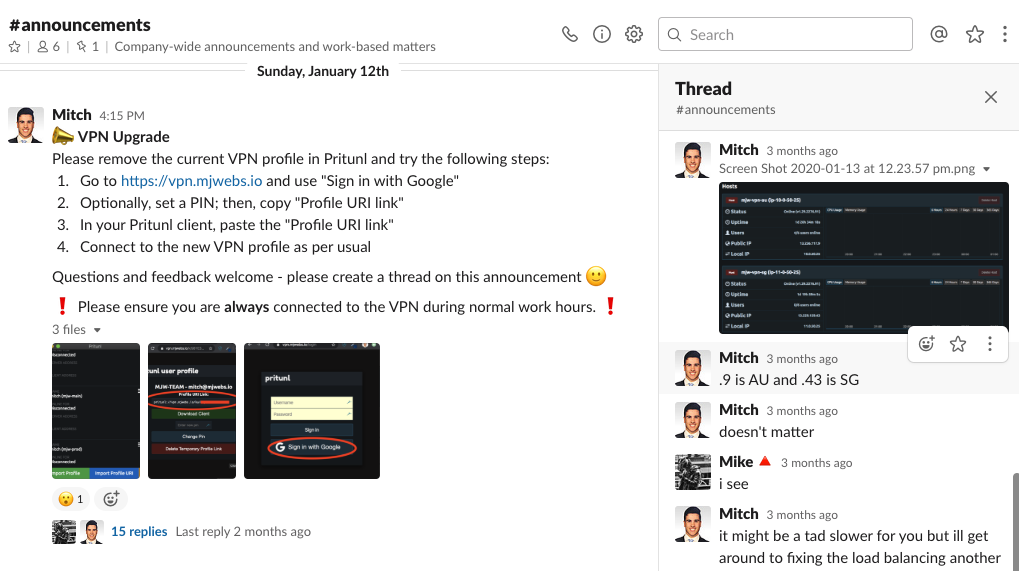
You will no longer need to worry about accidentally missing people in the "CC" list on your email because all staff are already in the #announcements channel by default.
You can learn about channel posting permissions on Slack here.
3. Stop using other instant messaging platforms.
In addition to sending pointless team emails, depending on how you're feeling, you probably also communicate over a plateau of other applications such as iMessage, Facebook Messenger, FaceTime, Skype, WhatsApp, WeChat, Tinder, or fax. It's really great that you and your team like to keep things interesting for each other, but this is total chaos and you should stop this immediately.
Enforce Slack as the exclusive messaging platform.
You should make it a company-wide policy that no other instant messaging platform are to be used for work-related discussions. When everything is in one place, everyone is always on the same page and nobody misses out on important information.
Use Slack for video/audio conferencing.
Unknown to many, Slack has a highly intuitive video conferencing feature that lets you screen share and draw on the screen. This is not only endless fun but endlessly better productivity than joining a call on whichever platform your coworker is using on that particular day.
“But the latest hype right now for #RemoteWork is Zoom. How else do we show that we’re #WorkingFromHome?"
Sarcasm aside, if your organisation’s main communication platform (e.g. Slack) supports video conferencing, you should opt to use this instead. Keeping things in the same place is ideal for the following reasons:
- Gentle learning curve; once your team learns the basics it becomes second nature.
- Less software to keep up to date on your team’s devices.
- Predictable setup; your team will know how to configure the microphone and camera settings every time.
4. Set channel conventions and policies.
You should be able to look at a channel name and instantly know what it is for. You can use a straight forward naming convention for public staff channels, for example #announcement, #reports and #worldaffairs. You should use a more distinct naming scheme for projects and clients, for example, #project-clientname.
Use “channel topic” for channel rules.
Define in concrete what each channel should be used for by using the channel topic. For example, if your organisation has a #worldaffairs channel, your team should know that it's not a channel for discussing a client's request or for opinion pieces.

Do not allow your staff to create their own channels.
Channels should be deliberate and thoughtfully implemented. The channels in your Slack workspace should be modelled as closely with your actual organisational structure as possible. Giving everyone the ability to make their own channels is like having a company structure that is constantly changing.
Keep channels public until they should be private.
Public staff channels include channels for announcements, inspiration, general discussions, internal topics and concerns, etc. These channels are for things that should be public knowledge for all employees. Private channels, on the other hand, should only include members who are involved with the specific project that the channel is for. Having a separate private channel for clients and projects will avoid mixing or losing details.
Permit a change management process.
Organisations are dynamic and it's okay to make changes to channels and the way your organisation uses Slack.
5. Stop having private conversations.
Well, don't have private conversations when it's not necessary. Getting in touch with any member of any department is now much easier with Slack, but you should avoid the temptation to send direct messages when there is a dedicated channel.
Use threads to chat one-on-one.
Keeping project related conversations on the appropriate channel makes sure that each member of the team is in the loop of the process. If you're worried about your conversation adding unnecessary clutter to the channel, just turn it into it a thread. The other members of your team will likely just glance over it, but the important thing is that it's still there for them to read if ever required.
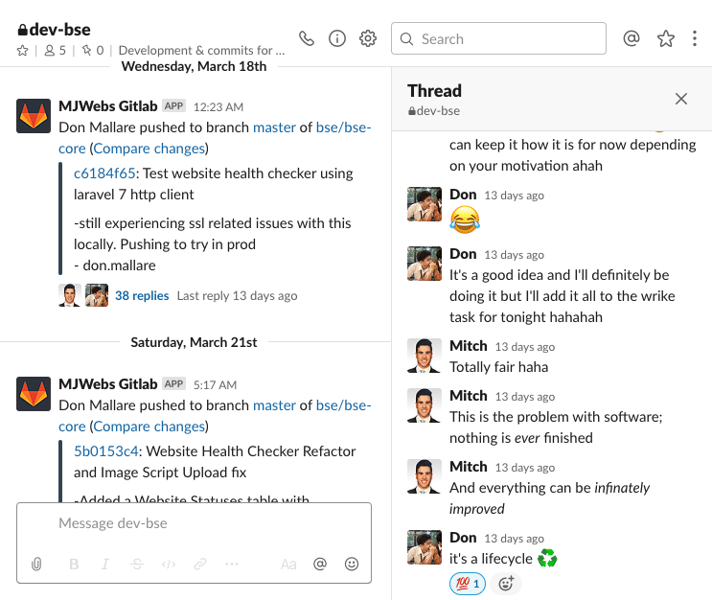
6. Stop repeating yourself.
All these instant messaging platforms have the tendency to become cluttered very fast when people start asking questions that have already been answered, or request files that have already been uploaded.
Find the original message.
When someone asks a question or makes a comment that has already been addressed previously, do not type out the same information again. Choose one of the following options:
- Find the original message - tag the person in the original message thread.
- Find the original message - copy the permalink of the message and send in the chat with a friendly reminder to keep up to date with missed messages.
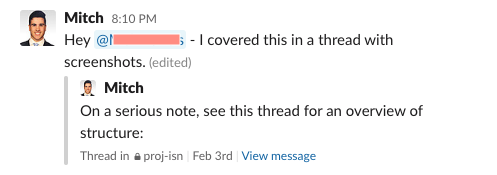
Share messages from other channels.
If a message you posted in another channel is relevant to a conversation in a different channel, simply share the original message to the new channel.
Pin important messages and files.
If a piece of information is repeatedly asked for, or if you can foresee that your message might be important for later down the track, just "pin" the message to the channel. This way it can be found quickly by looking in the channel's sidebar.
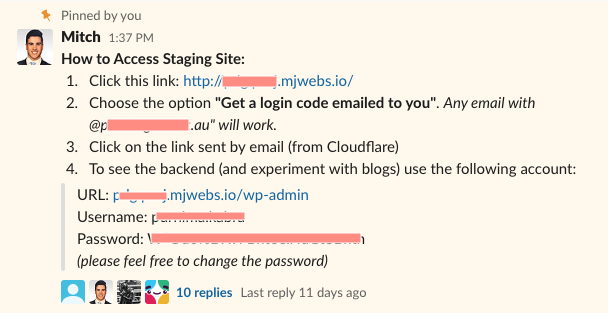
7. Enforce reporting at start and end of day.
Create a channel for SOD (Start of Day) and EOD (End of Day) reports. This is where each member of the team sends their schedule for the day. This allows managers and each teammate to know what everyone is working on. This is also where the team will submit their report stating what they have accomplished for the day.
Tip: Have the EOD posted as a reply to the SOD for easier and cleaner monitoring. It also put the two reports in a thread which makes it easier to view.
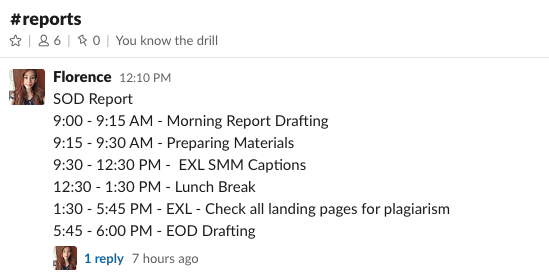
8. Create channels for non-work related discussion.
The people in your organisation are human beings. It's important to make sure that you are facilitating an environment that can cater for the personal needs of your employees.
Create an #inspiration channel
The purpose of this channel is to become your very own internal "Pinterest" in which your team members can post and discuss initiatives and precedent from other businesses that may be of interest. After building up a library of precedent, each post can be used as a permalink to use in other discussions later down the track.
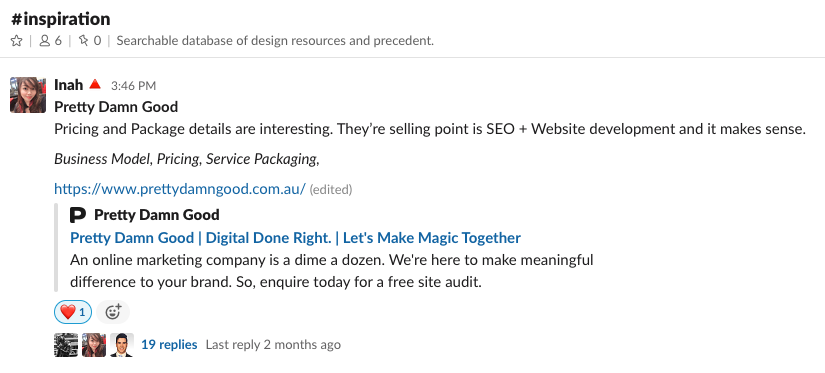
Keep the #random channel.
The #random channel comes in your slack workspace by default. Hold onto it. It's perfect for sharing articles, memes, ideas, pictures or videos that don't quite have anything to do with work or any other channel. This should be encouraged; your team members deserve the opportunity to share content that is important to them personally.
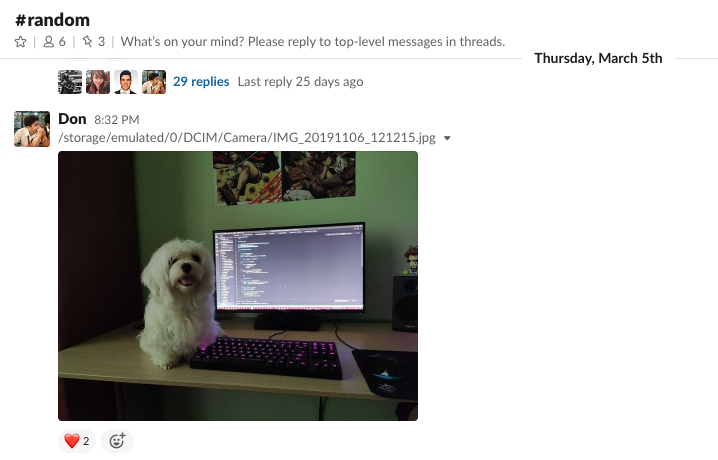
Create a #fitness or #lifestyle channel.
It's great to celebrate personal achievements outside of work. The app we use for this is called Slava (Strava Integration).
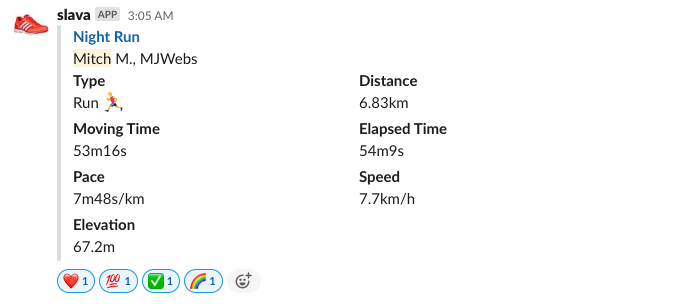
Create a #situation channel (for emergencies).
Some emergencies need to have their own channel because of potentially severe impacts to your team or organisation. For example, the COVID-19 situation is a big deal, and it is affecting teams all over the world - creating a channel solely for this emergency allows everyone to share their current situation amid the pandemic. Another use-case of the #situation channel is during widespread service/power outages that will heavily affect business in the short term.
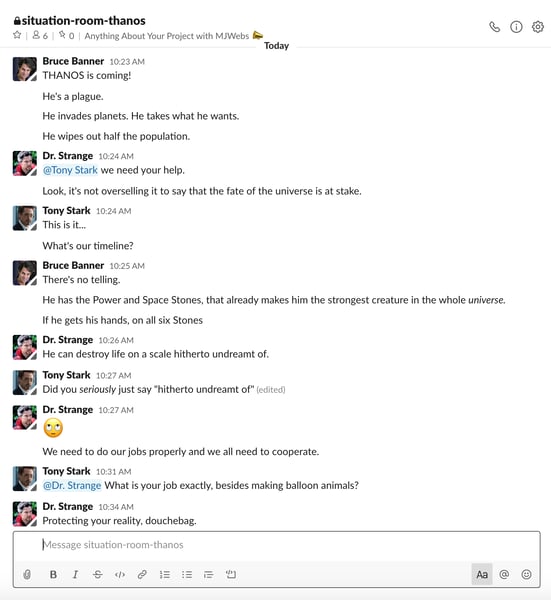
When the "situation" is over, simply archive the channel. We look forward to archiving our #situation-covid-19 channel.
9. Work with people outside of your organisation.
Use shared workspaces for external organisations.
Shared organisations allows you to connect securely with another Slack organisation's workspace.

Add external users as single-channel guests
This will bring your team closer to your clients. Having your clients within Slack allows you to discuss the details of a project freely and easily.

10. Leverage available integrations.
It's almost certain that there will be a Slack app for each of the other applications used in your organisation.
Pingdom Integration
We use our #alerts channel to receive Pingdom alerts in real time. When high priority alerts come in, it's easy to discuss the affected resources immediately in the context of the notification.
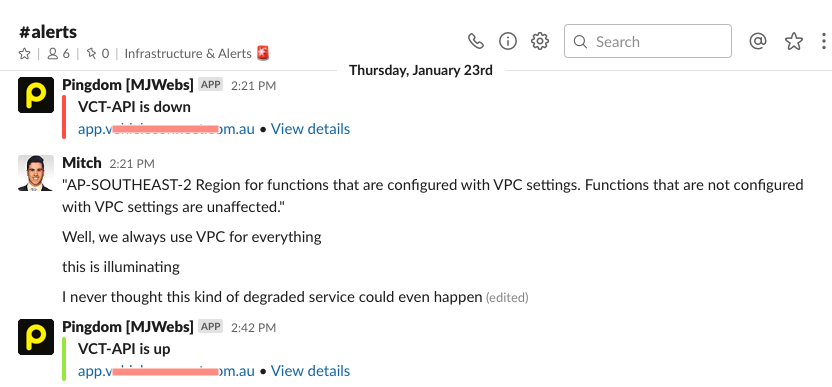
Gitlab Integration
We use the Gitlab integration to communicate our latest code commits with our clients as well as directly discuss ideas in threads.
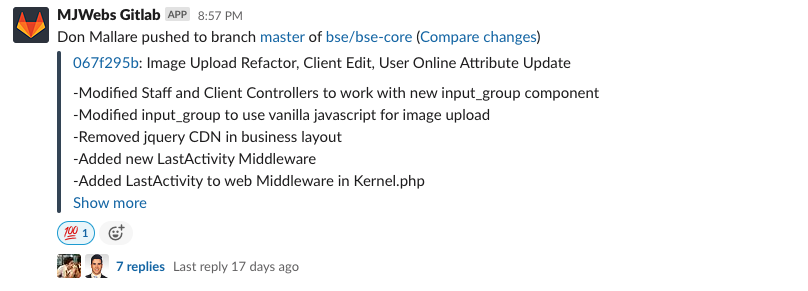
Wrike Integration
When a task on Wrike is completed or in progress, we can preview it easily in Slack for the benefit of clients or to discuss the task with the team.
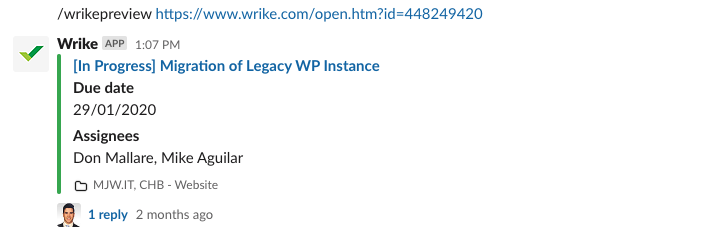
Twitter Integration
We use this to keep up to date with ~~the latest hype~~ significant creators and developers such as Taylor Otwell (creator of Laravel), Adam Wathan and Steve Schoger (creators of Tailwind CSS and Tailwind UI).
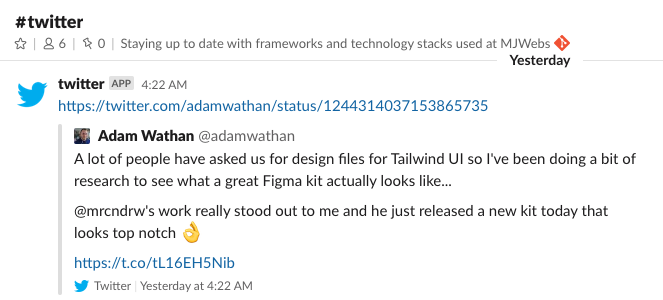
Conclusion
When you start using everything properly, Slack is capable of becoming a phenomenal communication tool that could make your organisation more efficient, effective and even more "human".